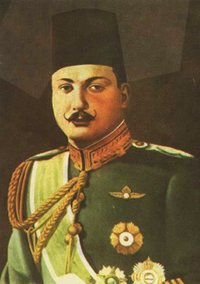Farouk of Egypt
|
|
King Farouk of Egypt (February 11, 1920 – March 18, 1965) was the penultimate King of Egypt, succeeding his father, Fuad I, in 1936. His sister Fawzia was Queen of Iran for a brief period. His full title was "H.M. Farouk I, by the grace of God, King of Egypt and of Sudan, Sovereign of Nubia, of Kordofan and of Darfur".
Reign
Upon his coronation, the 16 year-old king made a public radio address to the nation, the first time a King of Egypt had ever spoken directly to his people. His father Fuad I did not speak any Arabic and relied on representatives to make his wishes known to his subjects in their native language.
The teenage monarch was enamored of the glamorous royal lifestyle. Although he already had thousands of acres of land, dozens of palaces and hundreds of cars, the king never seemed satisfied with his wealth. He would often travel to Europe for grand shopping sprees.
During the hardships of World War II, criticism was leveled at Farouk for his lavish lifestyle. His decision to keep all the lights burning at his palace in Alexandria, during a time when the city was blacked-out due to Italian bombing, was deemed particularly offensive by some. The royal Italian servants of Farouk were not interned, and there is an unconfirmed story that Farouk told British Ambassador Sir Miles Lampson (who had an Italian wife), "I'll get rid of my Italians, when you get rid of yours."
The King's alleged corruption in Egypt and defeat during the 1948 Arab-Israeli War, led to a military coup on July 23, 1952, directed by Gamal Abdel Nasser, who forced Farouk to abdicate and exiled him to Italy and Monaco, where the former king lived the rest of his life. Immediately following Farouk's abdication the monarch's baby son, Fuad II, was proclaimed king, but for all intents and purposes the monarchy had been de facto abolished. In 1953 it was formally abolished and a republic was declared.
The new regime quickly moved to auction off the King's vast collection of trinkets and stolen treasures. Among the more famous of his possession was one of the rare 1933 Double Eagle coins, though the coin disappeared before it could be returned to the United States.
Farouk continued to live a lavish life even in exile, and continued his obsessive accumulation of material goods. His gluttony for fine cuisine soon made the former king dangerously obese, weighing nearly 300 pounds (140 kg) – an acquaintance described him as "a stomach with a head". He died in Rome, Italy on March 3, 1965. He collapsed and died at the dinner table, following a characteristically heavy meal.
In addition to an affair with the British writer and siren Barbara Skelton, among numerous others, the king was married twice, possibly three times. His first wife was Safinaz Zulficar (1921–1988), a pasha's daughter who was renamed Farida upon her marriage; they married in 1938, divorced in 1948, and had three daughters. His second was a commoner, Nariman Sadeq (1934–2005); they married in 1951 and divorced in 1954; they had one son, Ahmed Fouad, a.k.a. Fuad II. In 2005, Irma Capece Minutolo, Princess of Canosa (1941-), a retired Neapolitan-born opera singer, declared in an interview published in Al-Ahram that she married to the exiled king in 1957, when she was 16, and that she was writing her memoirs of her life with him.
The actor David Suchet modelled his mustache for detective Hercule Poirot on King Farouk's.
See also
Reference
| Preceded by: Fuad I | King of Egypt 1936–1952 | Succeeded by: Fuad II Template:End boxde:Faruq ms:Raja Farouk I nl:Farouk I van Egypte |

